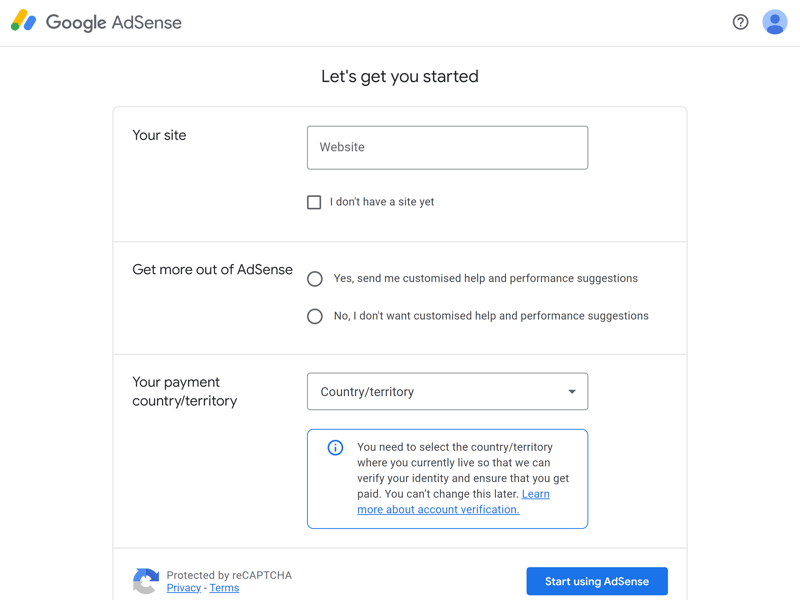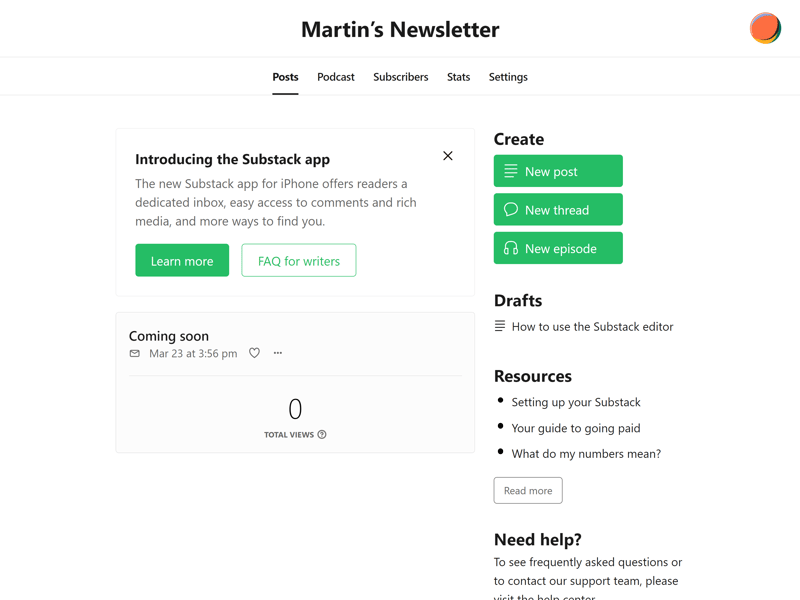How To Make Money Blogging: 7 Ways to Monetize Blogs
Loving money and loving writing aren't opposites. A good blog can combine both - you just need the right monetization strategy. But how exactly can you make money with a blog, and which method works best?
We'll show you different ways to make money with blogs and blog posts, and what you need to get started.
8 Ways to Make Money Blogging
There are many ways to monetize blogs. Each method requires different effort and offers varying earning potential.
You can combine different strategies to create multiple income streams. This helps you avoid depending on specific channels that might quickly change or lose relevance in the fast-paced online world.
Here are eight proven ways to make money blogging:
Display Advertising
While people who use ad blockers don't see them, ads are still everywhere. For bloggers, they remain one of the most profitable income sources in 2024: According to GrowthBadger statistics, Google AdSense is actually the most popular monetization method.
How Does Monetization With Ads Work?
If you want to make money with ads, you have two main options:
- 1.
You can use ad networks like AdSense mentioned earlier. These networks act as middlemen between you and advertisers, automatically selecting ads that match your content and audience. You'll receive regular payments. You don't have to manage anything yourself, but you'll need to share some of your earnings with the networks.
- 2.
Or you can sell ad space directly. This means finding advertisers yourself, negotiating prices, and placing ad banners. It takes more work - but you'll keep more money, can set your own terms, and have full control over the ad content.

Google AdSense is by far the most popular ad network.
There are many ad networks with different target audiences and terms. Here's a quick overview:
Google AdSense: Google AdSense is many bloggers' first choice because it makes adding ads super easy, enforces strict quality guidelines, and has no minimum traffic requirements. You can get paid once you reach $100.
Ezoic: Ezoic is a technology platform that helps digital publishers make money through various monetization features and improve their websites overall. It works for projects of any size: There's no pageview limit, but websites must follow Google's guidelines.
Monumetric: Monumetric is a network for medium to larger blogs. It pays much better than AdSense - but your website needs to meet certain criteria to join one of Monumetric's programs. The minimum is 10,000 pageviews per month.
Mediavine: Mediavine targets large blogs: New members need at least 50,000 sessions per month and must meet specific content quality standards.
Raptive: Raptive is an ad network for creators that's especially strong in home & family, lifestyle, food, and pet niches. It's only suitable for larger websites: To qualify, your website needs at least 100,000 pageviews per month.
Pros and Cons of Display Ads
Easy to get started
Platforms like Google AdSense make it simple to start monetizing, even for beginners with no direct advertiser contacts.Highly scalable
As your traffic grows, your ad income can grow exponentially without requiring the same increase in work from you.Automated audience targeting
Ad networks automatically match ads to specific audiences. This makes ads more relevant to your visitors and can lead to more clicks and higher earnings.Optimization and insights
Many networks offer advanced features like A/B testing, insights, or AI tools for dynamic ad adjustment. This helps you maximize your ad revenue and gain valuable insights.
Income depends heavily on traffic
You'll only make serious money with significant traffic - which takes time to build. Small blogs won't earn much from ads.Can hurt user experience
Pushy ads can drive visitors away. Ads can also slow down your website's performance.Limited control
Depending on the network, you might have less control over what kind of ads show up on your site. Sometimes ads might not match well with your content.Ad blockers cut into revenue
Ad blockers are great for users - but they're a real problem for advertisers. Blocked ads mean no money.
Affiliate Marketing
Affiliate marketing is a more subtle way to monetize. You place links on your blog to specific websites or products from partner sites, and you get a commission when someone makes a purchase or takes a specific action through these links.
How Does Affiliate Marketing Monetization Work?
First, you need to find the right affiliate partners. Like with ads, you have two options that require different levels of effort:
- 1.
You can join affiliate networks. These networks connect website owners with advertisers. After signing up, you'll get access to many affiliate programs from different companies and brands. You can browse available programs, compare terms, and sign up for the ones that best match your content and audience.
- 2.
Or you can contact companies directly that have their own affiliate programs. This way, you can negotiate terms and build closer relationships with companies. You can earn higher commissions this way - but you'll have to handle everything yourself, from finding affiliates to tracking your affiliate links.
Commission rates in affiliate marketing vary a lot depending on your niche. The most profitable areas include finance, fitness & health, and technology.

Affiliate networks give you access to advertising opportunities.
There are many affiliate networks to choose from, and each gives you access to different brands, products, and companies. Here's a selection of popular networks:
Amazon Associates: With Amazon's affiliate network, you can earn commissions by linking to Amazon products. It's quick to set up, offers a wide range of products, and works for pretty much any niche.
financeAds: financeAds is an affiliate network focused on the finance industry, working with banks, insurance companies, and fintech firms. It's perfect for blogs about financial topics.
CJ: CJ is one of the biggest affiliate networks worldwide and offers access to thousands of affiliate programs across different industries. It provides advanced tracking and reporting tools to help you improve your campaigns.
impact.com: impact.com is a platform for managing advertising and affiliate partnerships. It gives you access to thousands of brands and a comprehensive dashboard to optimize your partnerships and gain useful insights.
Awin: Awin is a global affiliate network with thousands of partner programs, including well-known brands like SIXT, Myprotein, O2, and Center Parcs.
ShareASale: ShareASale is also part of the Awin group. It connects bloggers and other publishers with over 30,000 advertisers, including both larger companies like Etsy and many smaller brands.
Pros and Cons of Affiliate Marketing
Less noticeable than ads
While affiliate links must be disclosed, they're less obvious than regular ads.Higher earnings possible
Affiliate marketing is performance-based. Good affiliates can often earn more than with regular advertising, especially with products that offer attractive commission rates.Easy to set up
You just need to sign up for affiliate programs and add links to your content. Getting started and scaling up is pretty straightforward.Flexibility and variety
You can choose from a wide range of products and services to promote. This lets you pick offers that best match your content, niche, and target audience.
Disclosure requirements
Affiliate links can't be hidden: you must disclose them to follow legal requirements and be transparent with your readers.Possible loss of trust
If you overdo affiliate marketing or aren't transparent enough, readers might question your honesty or editorial independence.Dependence on third parties
Your income depends on affiliate program terms and reliability. These conditions can change quickly.
Partnerships with Sponsors
There's a middle ground between obvious ads and "invisible" affiliate marketing: sponsored content. This involves partnerships between bloggers and companies or brands. Companies pay bloggers to create specific content for their website - like product reviews, how-to guides, case studies, or giveaways.
The sponsored content is published like regular blog posts and blends seamlessly with your existing content, but you must label it as sponsored posts.
How to Make Money With Sponsored Content
First, you need to find the right sponsors for your blog. Look for sponsors who:
match your blog's content.
offer real value to your readers with their products and services.
see your blog's potential and are willing to pay for a partnership.
You can find sponsors through advertising and affiliate networks. However, it's usually better to find and contact sponsors directly - after all, with sponsored content, it's crucial that the advertised brand fits your blog and its target audience.
When you reach out to sponsors directly, you have more control over partnerships, better negotiating power, and can build personal relationships that lead to long-term collaborations.
This process can take time since you need to identify brands, find contact information, write outreach messages, and negotiate partnerships on your own.
Pros and Cons of Sponsored Content
More subtle than traditional ads
Sponsored content blends naturally with your platform's content and maintains an appearance of editorial independence while subtly communicating the sponsor's message.High earning potential
You can negotiate good rates when you offer real value to your sponsors.
Must disclose sponsored content
You must clearly label sponsored content - otherwise, you risk legal issues.Possible loss of trust
While sponsored content is more subtle than ads, some readers might see it as less honest. You might lose readers who question your editorial independence.Takes time and effort
Finding sponsors, reaching out to them, and negotiating deals takes considerable work.
Selling Products and Services
With ads and affiliate marketing, you help others sell their products. Why not become a seller yourself? You can potentially make good money by selling your own products through your blog - though it usually requires more effort and investment.
How Can I Sell Products?
The most important thing is choosing your product(s). You have two options:
- 1.
Digital products: Digital products like courses, ebooks, or software tools are great because they don't need storage or shipping. Customers can download them right after purchase and start using them immediately.
- 2.
Physical products: You can also sell physical products. If you have a large product range, you should set up a proper online store, but you can also add a sales system to your blog or link to products in your store.
Pros and Cons of Selling Products
High income potential
Selling your own products can make you good money. You keep all the profit instead of just getting a small commission like with ads or affiliate marketing.Control and flexibility
You have full control over your product design, pricing, and marketing. This lets you quickly respond to market trends and adjust your offers as needed.Independence from third parties
You're not tied to affiliate networks or ad partners and their rules - you're in the driver's seat.Brand building and customer loyalty
Real products feel more personal than links to partner offers. Selling your own products helps build your brand and can create stronger customer relationships.
Investment and risk
Developing and making products (especially physical ones) needs upfront investment. This creates more financial risk compared to making money through ads or affiliate marketing.Not passive income
Selling products takes more work than passive income sources. Even many digital products (like courses) need ongoing support and regular updates.Storage and shipping
Physical products need storage space and quick shipping after orders come in. This means extra costs and more things to manage.Customer service and support
When you sell your own products, you're responsible for customer service. This can take up a lot of time, especially when there are problems with products or shipping.
Premium Content and Memberships
Some people are still willing to pay for quality content. You can monetize your expertise through premium courses and paid memberships by turning some of your readers into paying customers. However, you'll need content that's worth paying for - which isn't easy in today's world where so much is free.
How Does Monetization Through Premium Content Work?
First, you need to decide which content to put behind a paywall and what pricing model to use. The most popular options include:
Online courses: If you run a how-to blog on a specific topic, online courses are a great way to package your expertise into a premium product. Your readers get access to detailed guides, step-by-step tutorials, and exclusive materials that go beyond the basics and offer deeper insights into the topic.
Members-only area with extra content: Many podcasts and online newspapers now use a classic freemium model: some episodes/articles are open to everyone, while others need a paid membership. You can add a similar members-only section to your blog that gives readers extra articles, exclusive interviews, and early access to new content that isn't available to the public.
You can set up premium content directly through Content Management Systems (CMS) like WordPress using special plugins that enable paywalls or membership areas.
Pros and Cons of Premium Content
No dependence on advertisers
When your blog is reader-funded, you're only accountable to your readers - not to third parties like companies or advertisers who might try to influence your content.Memberships provide steady income
A subscription model with monthly payments helps you plan your finances better. Income is more stable and not directly tied to fluctuating monthly visitor numbers.Building a community
A members-only area helps you build closer relationships with your readers and create a community around your content. You might gain loyal readers who support you financially for the long term.
Not passive income
When you charge money for your content, you need to work hard at it - readers who pay expect quality. Even courses you sell for a one-time fee need ongoing support and occasional updates.Requires really good content
The internet is packed with free blogs and guides. If you want readers to pay, you need to offer something they can't easily find for free on Google.Upfront investment
High-quality online courses and supporting materials need to be created long before you can make any money. This means you'll need to invest time and resources upfront.
Coaching and Consulting
Once you've established yourself as an expert in a specific niche or field through your blog, you can make money by offering coaching sessions or consulting services.
You can sell these services to individuals or organizations, creating a second income stream alongside your blog.
How to Make Money With Coaching and Consulting?
Coaching can take different forms:
- 1.
One-on-one sessions: You can help clients with specific challenges through individual or group coaching sessions, either in person or via video calls.
- 2.
Workshops and seminars: You can organize online or in-person workshops for multiple participants. This is a great way to share your knowledge with a bigger audience and earn more money through registration fees.
- 3.
Long-term consulting contracts: Especially in business and tech fields, you can build a steady income through long-term consulting agreements.
No matter which path you choose: to succeed as a coach and consultant, you need to learn how to market yourself as a brand. This means having a strong online presence and using social media wisely.
Being an expert isn't enough: you need to package and market your expertise well to attract potential clients. Clear service descriptions and transparent pricing are key. You can set up a simple booking form on your blog to handle appointments.
Pros and Cons of Making Money Through Coaching
High hourly rates possible
Since coaching is a personalized service that offers real value to clients, coaches and consultants can often charge premium rates.Additional income stream
Coaching lets you build an extra income stream that's separate from your blog content.
Requires expertise and public speaking skills
Coaching and writing are very different skills: to succeed as a coach, you need both deep knowledge in your field and strong people skills. You need to be comfortable speaking in front of others, not just writing behind a laptop.Many questionable providers
"Coach" isn't a protected title - this means there are many self-proclaimed coaches and gurus with questionable qualifications. Many people are (rightfully) skeptical about online coaching promises.Limited scalability
There's a natural limit to how many clients you can personally work with, which makes coaching less scalable than products, ads, or online courses.
Selling Your Blog
Don't want to keep running your blog anymore? You can try this final way to make money: Just like any other website, you can sell your blog to the highest bidder.
How Can I Sell My Blog?
You can either sell your blog on your own by reaching out to potential buyers, or use marketplace platforms like Empire Flippers, Flippa or Traderoo that help with the sale process.
To learn more about how to sell a website and what you need to keep in mind, check out this guide:
Pros and Cons of Selling Your Blog
Potential for a big payout
If you run a successful blog, selling it can bring in many times your monthly income.Even smaller blogs can be sold
Your blog doesn't need to be a huge hit to have market value. As long as you have a good domain, quality content, and relevant backlinks, you can sell even a small blog for profit.
One-time payment
When you sell your blog, you'll lose all other blog-related income streams. Think carefully about whether the one-time payment is worth it.Blogs are often tied to personalities
Selling a blog can be trickier and less profitable than selling a regular website. This is because blogs are often tied to a specific person or personality, which gets lost in the handover.
How Do I Start a Blog?
Don't have a blog to monetize yet? If you're just starting out, your first step is to pick the right blogging platform. Here are your main options:
Publishing Platforms
An easy way to start blogging is to use standard platforms like Medium or Substack. These let you publish content quickly and easily without any technical know-how.

Substack is an online platform for bloggers and podcasters who want to easily monetize their content.
The downside: You have limited options to customize the design or features, and you don't really own your blog since the content lives on the platform's servers.
Substack is popular with established journalists and writers who already have a large following. As a new blogger, it can be tough to stand out and build your own readership in this environment.
Website Builders
Want more control over how your blog looks and works? Website builders are a beginner-friendly way to create a blog.
Website builders give you all the design and management tools you need to run a blog in one place. You can design your blog and its posts using a drag-and-drop editor and add all common monetization options.

All website builders come with built-in blog features.
You don't need to worry about hosting or security - it's all included in the package. Most website builders also include a free domain for the first year.
Self-Hosting Your Blog
Want even more control over your blog? You can host it yourself. You'll need web space from a hosting provider and a content management system to manage your blog content. WordPress is by far the most popular CMS and works great for blogs.

WordPress is the world's most used CMS.
Self-hosting a blog takes more work and technical know-how, but beginners can do it without coding or design skills. You'll have many more options for customizing your blog's design and features, but you'll also need to handle more things yourself.

Conclusion
You can make money blogging in many ways: from advertising revenue and affiliate marketing to selling digital products and services, membership models, and sponsored content. Using different ways to make money can help you create multiple income streams and reduce risk.
The key is finding the right way to make money that works best for your blog. Affiliate marketing isn't great for blogs without a clear niche, and expensive online courses won't work for beginners who aren't seen as experts in their field.
Having the right expectations is just as important: blogging is not a get-rich-quick scheme. You can only build a loyal readership and make good money through consistent work and smart planning. If you're ready to take this long-term approach, you can join the small group of bloggers who find blogging both personally and financially rewarding.
Frequently Asked Questions
Some bloggers make a few hundred dollars per month, others thousands or even tens of thousands - and most make nothing at all. Your potential earnings depend heavily on your niche, target audience, blog reach, and how you choose to make money.
Yes, you can make a living from blogging, but it needs a large readership, good money-making strategies, and constant work. Most bloggers don't live (mainly) off their blog income - and for those who do, blogging is often a full-time job.
Starting a blog doesn't have to be expensive. You can use platforms like Substack or Medium for free, and website builders offer free plans too. However, if you need more control over your blog, you'll need to pay. Website builders cost about $10-30 per month, while a self-hosted blog might be even cheaper.
















